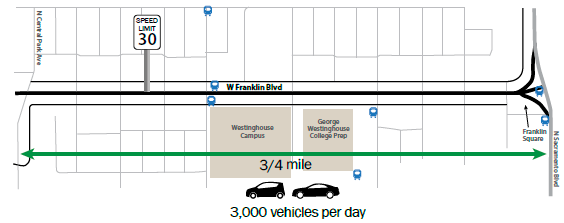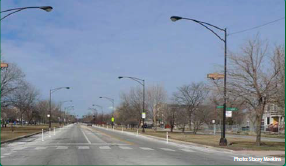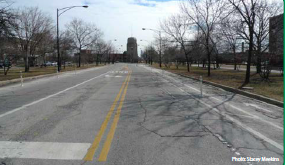ROAD DIET IMPROVES BICYCLE CONNECTIVITY, ENHANCES LIVABILITY
| Objective | Features | Results |
|---|---|---|
|
|
|


BACKGROUND
As part of Chicago's plan to expand the mileage of bicycle lanes, the ¾-mile Road Diet on Franklin Boulevard from Sacramento Boulevard to Central Park Avenue transformed a 4-lane roadway to a 3-lane roadway with separated bicycle lanes in each direction.
Franklin Boulevard has good access management, with limited intersecting roadways and parallel one-way service roads alongside the main throughway separated by a planted median. The sidewalks serving the neighborhood are located along the service roads. The land use along Franklin Boulevard is primarily residential but also contains two schools, a veterans home, and a hospital.
 3-lane cross-section with bollard-separated bicycle lanes |
 Cross-section at an all-way stop intersection |
SEPARATED BICYCLE LANES
With Franklin Boulevard's relatively low average daily traffic (ADT) of approximately 3,000 vehicles, traffic congestion was not an issue on this corridor. The reason for this Road Diet conversion was due to Chicago's plans to further expand and connect the bicycle facilities throughout the city. The project allowed for the installation of bicycle lanes with a buffer space delineated with vertical bollards to separate vehicles and bicycles.
The biking community has been excited and supportive of Chicago's overall expansion plans, "Thanks to these new facilities, Chicago's streets have never been safer for people on bicycles. And people of all ages are taking their first bicycle ride in years, further expanding Chicago's bicycling community and helping us build momentum for better cycling conditions."1
"Chicago's streets have never been safer for people on bikes"
RESULTS
Speeding and congestion were not issues for this corridor before or after the conversion, but the Road Diet produced positive "livability" or "quality of life" changes, such as:
- Residents along Franklin Boulevard felt the re-design improved both safety and the ability of children to bicycle to school.
- A veterans home along Franklin Boulevard, which provides bicycles to their residents and visitors, expressed appreciation for the addition of the separated bicycle lanes in the area to keep this particularly vulnerable user group safe and mobile.
- The additional bicycle lanes connect three area parks – Garfield Park, Central Park Boulevard, and Franklin Square – lengthening the mileage for recreational bicyclists.
- The additional bicycle lanes improved the connectivity to public transit, community institutions, and several parks.
1 "Chicago Bikeways Continue to Bloom This Week – Read the Latest Update!" Blogpost Active Transportation Alliance, May 21, 2012 Accessed March 30, 2015. Available at: http://activetrans.org/node/9098
